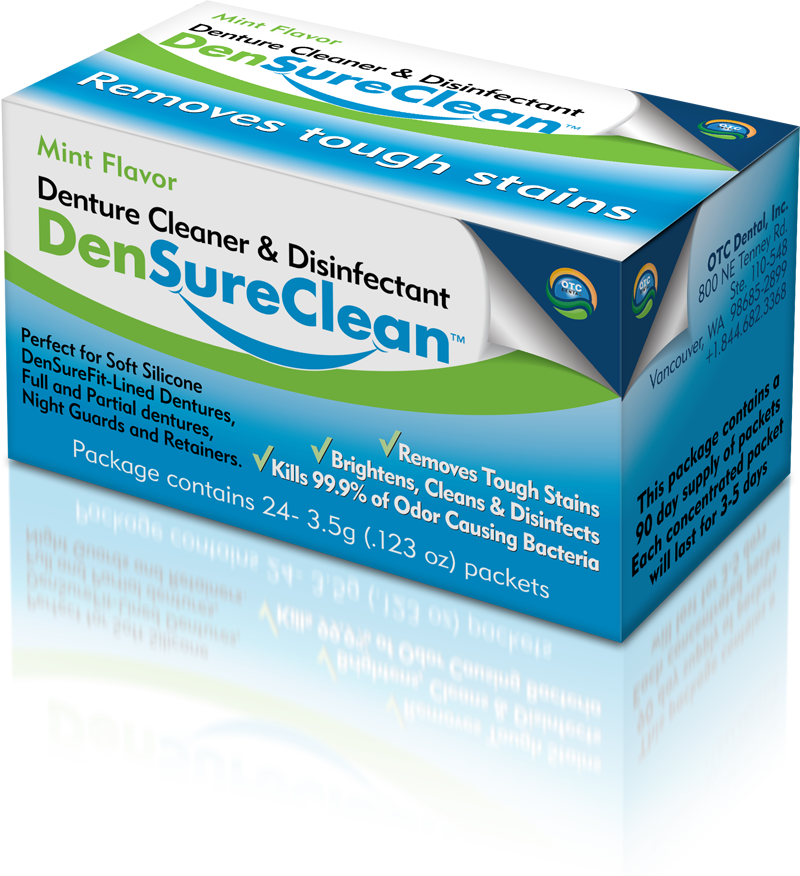Can DenSureFit be used on LOWERS?
Yes!
DenSureFit may be used on the lower denture plate.
What to EXPECT from DenSureFit on the LOWER
Fills voids.
DenSureFit silicone does a wonderful job of filling voids that are causing your lower denture to fit too loosely.
Cushions.
DenSureFit silicone provides soft cushioning against the hard acrylic denture base. It can help and/or prevent gum soreness.
Provides better seal.
On a well-made denture, DenSureFit can also provide a nice seal around the edges and ridge of your denture to help keep food and liquids out.
NOTE about a FLOATING or POPPING UP LOWER
Since DenSureFit is not an adhesive, it likely will not hold your denture down on your lower gum line. This is the job of an adhesive.
DenSureFit will do a great job of filling your voids in your lower. But, since a lower simply rests on the gum line and doesn’t get suction, most have a tendency to float or pop up.
In this case, the extra security of a powder adhesive works well in conjunction with the DenSureFit liner to keep the denture secured to the lower gum line.
Typical Results on the Lower Denture
Realistic expectations are important. Results vary per situation.
Short Walls
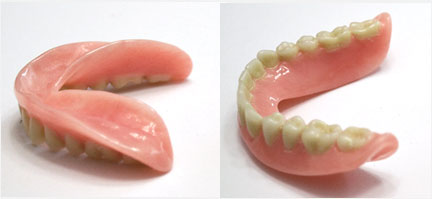
- Superior cushioning
- Powder adhesive VERY LIKELY to be required
- Able to eliminate cream adhesive
- DenSureFit cannot solve “floating” issue”
Tall Walls
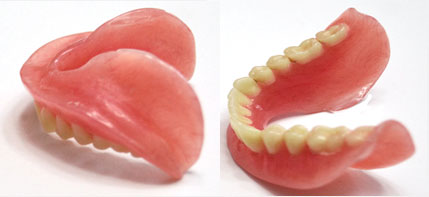
- Superior cushioning
- Increased chance of being adhesive-free
- Powder adhesive might be required
- Able to eliminate cream adhesive
Lower Dentures
If you are considering using DenSureFit on lowers, please read the following information for proper expectations. The PROCEDURE for relining the LOWER with DenSureFit is located at the end of this article or click here.
DenSureFit can provide cushion and comfort on lowers, but it is highly possible that you will still need adhesive to keep your denture in place. If you do need to use adhesive, we recommend a POWDER adhesive which works best with the DenSureFit silicone.
CAN DenSureFit BE USED ON LOWER DENTURES?
Even though DenSureFit is IDEAL for upper dentures, the product may be used on lower dentures as well. How much or how little it might help you can be determined by reading the following information. It is important that you have realistic expectations as to the results this product might offer for your particular lower denture situation.
Even experienced dentists encounter challenges when relining lower dentures. Most dentists will not guarantee that their soft reline will solve all your lower denture issues. Keep in mind that DenSureFit cannot guarantee to solve all your lower denture issues either; however, it may be a great help in making lower dentures better fitting and more comfortable to wear. Lower dentures are more challenging than upper dentures simply because they do not have the advantages of the upper palate shape in helping to create good suction.
Well-made lower dentures (those with sides that extend down to the bottom of the jaw bone) will typically get better results from applying DenSureFit. Trial and error may be necessary to achieve good results with the product on lower dentures. We provide a basic procedure to follow, but you should be aware that even in the best case scenario, you may still need to use powder adhesive over DenSureFit on your lower denture.
Dentures with low ridges and shallow troughs can benefit from the cushioning that DenSureFit provides, but DenSureFit cannot prevent your lower denture from popping (or “floating”) up off the gum line. Dentures that “float” off the gum line are not the best candidates for obtaining a better fit with DenSureFit. “Barely there” ridges and shallow troughs offer very little surface area for the denture to grab onto your gums. Unfortunately, DenSureFit cannot solve this issue. If this is your case, use DenSureFit solely for the comfort and cushioning benefits.
It’s also important to note that adding even a thin layer of silicone to your denture can sometimes actually make a shallow denture “float” even more. In those situations, you would still need to use powder adhesive to help keep your lower denture properly seated and you may still end up having issues. If you find yourself in this situation, consult with your dentist about options to improve your fit or remake your denture.
Short Walls
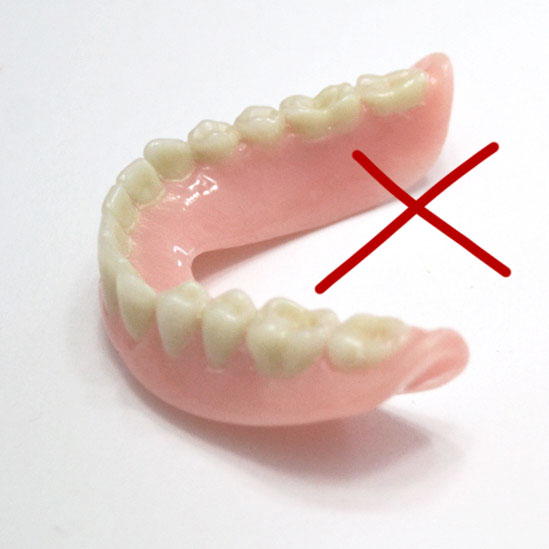
If your denture is shallow like this one, you can anticipate a soft cushioning effect from DenSureFit; however, it cannot solve other issues, such as preventing it from “floating”. Powder adhesive will be necessary on top of your DenSureFit liner.
Tall Walls

If your denture has sides that are more substantial and extend down onto the gums like this denture, DenSureFit might provide an improved fit and soft cushioning. Powder adhesive may or may not be necessary on top of the DenSureFit liner.
PROCEDURE
Lower Reline Instructions
For complete instructions on cleaning, priming, and activating the silicone applicator, click here.
Have an UPPER and LOWER?
Do not attempt to reline your lower plate until your upper fits properly. Always reline your upper FIRST and then your lower. Do NOT reline them both at the same time.
Please review Upper Reline Instructions or click here.
Step 1: Clean, Rinse and Dry Denture
Clean, rinse and dry your denture (click here).
Step 2: Apply PRIMER and let DRY 2 minutes.
Prime entire inside of lower denture and slightly over the ridge to the front of your lower denture (click here).
Step 3: Apply Silicone
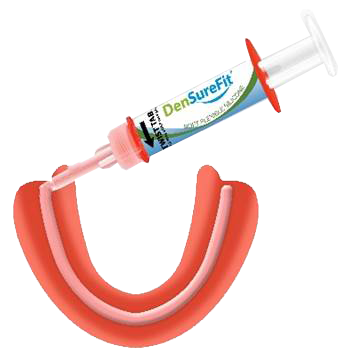
Step 4: Seat Denture
- Lightly place the denture onto your lower gum line. DO NOT press down with your fingers. Do NOT bite down, yet.
- Check your midline in a mirror: Ensure your 2 front teeth of your lower are centered with your 2 front teeth of your upper.
- GENTLY bring teeth together in a natural biting position.
- Look in the mirror and ensure they LOOK and feel like they are in the proper position…not too high and not too low.
Relax your lower jaw and let it hang slightly open. Set timer for 4 minutes and keep still while it cures. Do NOT remove the denture from your mouth until the 4 minutes is up.
Step 5: Assess Fit
After the 4 minutes, assess your fit.
SNUG!
If your denture is snug, you are done. Leave your denture to air dry outside of your mouth for 2 hours before wearing while it finishes curing. See back of booklet for trimming and care instructions or click here.
NOT SNUG?
Examine the silicone in your denture.
Did the silicone end before it reached the top of the denture wall? If the silicone ended before it reached the top of the wall, you may need more silicone to finish filling your voids. Proceed to the Snug-Up Procedure or click here.
If the silicone flashed all the way around the edges of your denture, then you have filled all the voids and you have a nice seal. This is likely the best fit that you are able to achieve. Use powder adhesive on top of your lining if you need extra security.
Floating, Lifting or Popping Up?
If your denture lifts off of you gum line and does not stay down, remember that this is not an issue that a soft reline can solve. Many lower dentures need adhesive to help keep the denture in place. If needed, we recommend using a powder adhesive on top of your DenSureFit liner as it is more compatible with the silicone.
Video: Lower Denture Instructions
PROCEDURE
Lower Snug-Up Application
Snug-Up Procedure For Lower Denture
If needed, use these instructions to snug up your lower denture immediately following your initial application or later if your denture gets loose.
DenSureFit silicone is build-able. If your denture gets loose after a good initial fit and your liner is in good condition, you can layer more silicone on top of your existing liner.
a. Clean and Dry Denture
Ensure your denture is perfectly clean and dry as you did in your initial application. Wipe down the inside of the denture with rubbing alcohol and let dry.
b. Prime Bare Spots
Dip a cotton swab into the primer and use that to prime any bare spots of hard acrylic on the ridge, along the back edge and slightly over the front of the ridge. Let the primer dry for 2 minutes. (The reason for the cotton swab is because you need very little primer to prime bare spots. The foam swab in your kit will use more primer than you need. Do not cover existing DenSureFit silicone with primer. It will not harm the silicone, it just is not necessary because the silicone will adhere to itself without the primer.)
c. Apply Silicone
d. Seat Denture
- IMMEDIATELY place the denture into your mouth.
- Bring teeth together in a natural biting position with MEDIUM pressure. STOP as soon as you feel your teeth make complete and proper even contact and it is properly seated.
- Look in the mirror and make sure that your denture LOOKS and FEELS like it is in the correct spot and that it is comfortable. Relax your lower jaw.
Set your timer for 4 minutes and keep your denture still.
- You are done. See back of this booklet for trimming and care instructions.
Don’t Wear Your Newly Relined Denture For 2 Hours!
After your reline is complete, leave your denture to air-dry outside of your mouth for 2 hours to finish curing.


 Relax your lower jaw and let it hang slightly open. Set timer for 4 minutes and keep still while it cures. Do NOT remove the denture from your mouth until the 4 minutes is up.
Relax your lower jaw and let it hang slightly open. Set timer for 4 minutes and keep still while it cures. Do NOT remove the denture from your mouth until the 4 minutes is up.